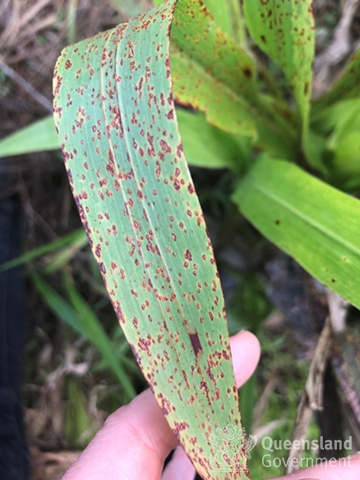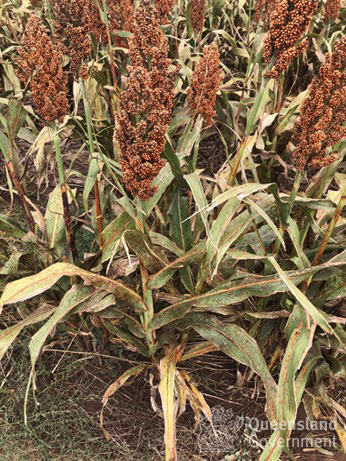
Rust symptoms appear as small purple-red spots on leaves that burst open to release masses of spores. Photo: Lisa Kelly, DAF
Disease surveys across northern New South Wales and southern Queensland have found that many sorghum crops have been impacted by rust. Sorghum rust is caused by the fungal pathogen, Puccinia purpurea, and is considered to be a relatively minor disease of sorghum in Australia.
Symptoms
Rust can infect sorghum crops at all stages of growth. Initial symptoms appear as small purple-red or tan spots on both upper and lower surfaces of the lower leaves. These spots enlarge to form raised pustules that rupture to release masses of reddish-brown spores. The pustules spread to all leaves and may also be found on the leaf sheaths and stem.
Rust spores can travel long distances in the wind and rain. The pathogen survives between cropping seasons on infected crops debris and on alternate hosts, such as Johnson grass (Sorghum halepense).

Sorghum crop infected with rust growing in Spring Ridge in northern NSW in March 2022. Photo: Lisa Kelly, DAF
Conditions that favour disease
Rust outbreaks typically occur late in the season, during the grain-filling phase and result in minimal losses in yield. However, disease outbreaks may occur earlier in the season when the crop experiences periods of cool, wet weather. Sorghum rust can reduce yields in susceptible varieties by 13% when infection occurs prior to anthesis (White et al. 2012). The disease is most severe during periods of high relative humidity, heavy dews, rainfall, and cooler temperatures. Rust may also predispose the crop to other diseases, such as charcoal rot.
Disease management
To minimise the impact of rust:
- Sow early or sowing shorter season varieties that mature earlier to avoid the optimal weather conditions for rust infection that typically occur later in the season
- Use disease-free seed and avoid planting seed from a previously infected crop. There is a risk that the fungal spores may be present on the seed.
- Rotate sorghum with non-susceptible crops
- Avoid planting varieties that are highly susceptible to rust
Inspect crops closely for disease. If you are unsure about symptoms in your crop, contact Lisa Kelly (0477 747 040 | [email protected]) for disease diagnosis.
This research is supported by the Grains Research and Development Corporation (GRDC) and co-invested by DAF through the project Disease surveillance and related diagnostics for the Australian grains industry (within the Northern region) (DAQ2106-007RTX)
Reference
White, J.A., Ryley, M.J., George, D.L. et al. Yield losses in grain sorghum due to rust infection. Australasian Plant Pathology 41, 85–91 (2012). https://doi.org/10.1007/s13313-011-0093-3
